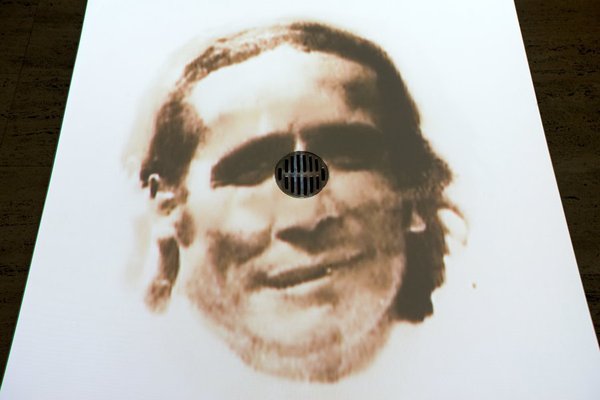

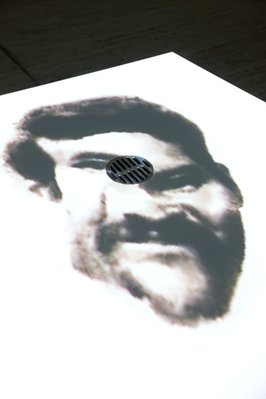
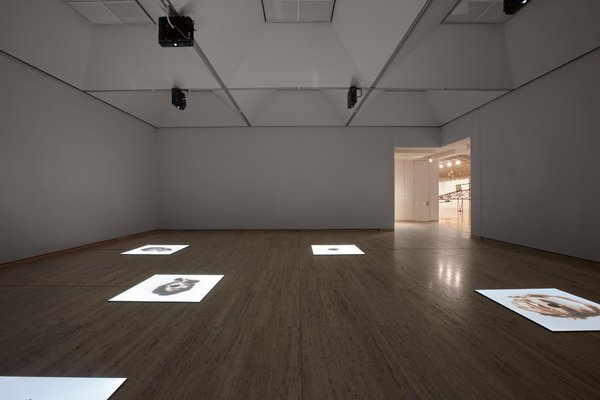
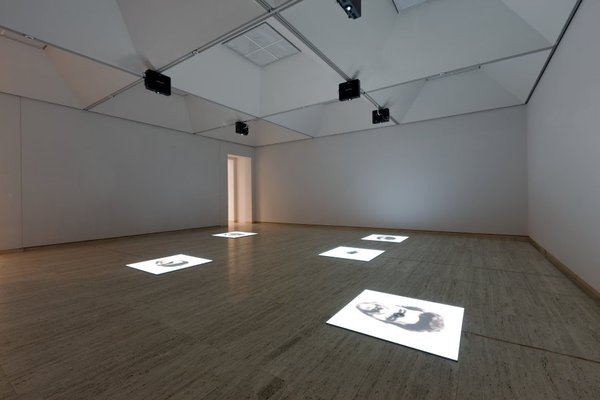
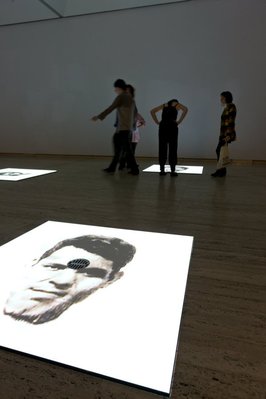

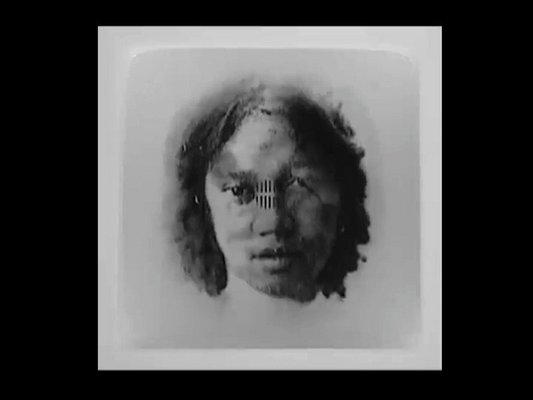
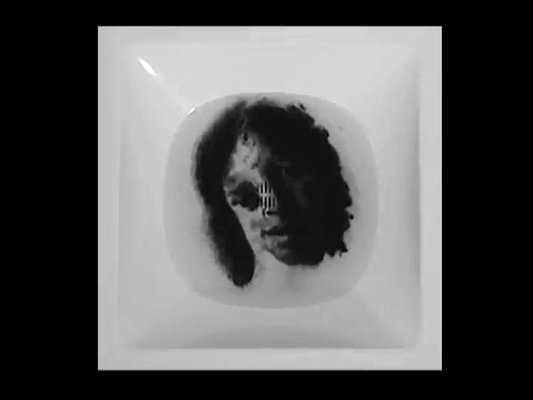
-
Details
- Alternative title
- Biografías
- Date
- 2002
- Media categories
- Installation , Time-based art
- Materials used
- nalog tape (miniDV) shown as five channel digital video projection, colour, sound, five metal drain grills, five MDF mounts
- Dimensions
- installation dimensions variable; duration: 00:02:40 min; aspect ratio: 4:3
- Signature & date
Signed and dated inside lid wooden box, black fibre-tipped pen "Oscar Munoz/ ... 2002/ ...".
Signed master tape, black fibre-tipped pen "Oscar Munoz....". Not dated.
Signed on DVD masters, black fibre-tipped pen "Oscar Munoz". Not dated.- Credit
- Purchased 2010
- Location
- Not on display
- Accession number
- 75.2010.a-o
- Copyright
- © Óscar Muñoz
- Artist information
-
Óscar Muñoz
Works in the collection
- Share
-
-
About
Óscar Muñoz is something of a gentle magician. His ‘disappearing’ drawings are poignant and beautiful, combining consummate skill with conceptual subtlety and rigour. Although Muñoz is not assertively political in his work which is more about mortality than specific acts of violence it is impossible not to look at it in the context of Colombian life. The situation in Colombia is still very difficult; in a recent visit to three cities in Colombia I met dozens of extraordinary artists of all generations from members of young collectives to senior artists like Doris Salcedo and Óscar Muñoz. Almost every conversation included a reference to the war. Technically there is no war however the effect on people’s lives is tantamount to warfare.
Drug barons have corrupted the guerrillas who ostensibly used to fight for better conditions for the marginalised rural communities including surviving Carib villages and communities of African Americans who descended from escaped slaves in earlier centuries. Now the guerrillas are just as likely to destroy the villages to make way for crops of cocaine and increasingly for opium poppies. The government once encouraged and supported the growth of paramilitary forces that could fight the guerrillas in the difficult jungles and mountain territory that divides Colombia into several isolated worlds beyond the reach of the government troops.
Unfortunately the paramilitary were also then corrupted and turned against the rural communities also in the pay of the drug industry. To all intents and purposes the only difference between guerrillas and paramilitary is their dress code. Today the paramilitary have been outlawed by the government but dozens of wealthy Colombians including members of parliament have derived fortunes from their support of and involvement in the paramilitary. Some of these are now being charged and jailed which indicates a real desire to make changes. I met many artists who bravely made art with the communities to “out” the corrupt politicians and drug barons; the mood of the people is overwhelmingly for peace.
When villages loose their land in this way or when it suits the barons to silence a community for any reason a common technique for social control has become the disappearing of people. The art historian, Charles Merewether has called this technique the dialectics of violence. This is the subject matter of much of the art I saw in Colombia notably Doris Salcedo’s monstrous memorials to the disappeared. Óscar Muñoz is different, more poetic and reflective and yet behind his achingly beautiful videos the theme of disappearance can not be ignored.
Muñoz combines traditional drawing skills with video in a completely original and surprising way. The first work I became aware of ‘Project for a memorial’ suggested a form of meditation but it also reminded me of the image of someone trying to empty the sea with a teaspoon or moving a beach grain by grain while the wind and sea roll fresh sand into place. The image on the screen was of a flat stone onto which Muñoz brushed water to create a beautiful likeness of various personalities. The hot stone evaporates the water image as fast as the artist’s hand could create it but he keeps remaking it always leaving us enough of an image for us to want to see it completed.
Although it is a very rough technique Muñoz manages to create hauntingly lifelike portraits that keep being reconstituted and fading before our eyes. I think of this action as a kind of mantra or a ritual of remembering, even as the world erases our efforts to fix an understanding of it. It might also suggest the hopelessness of Sisyphean efforts to contain the senseless violence that makes day to day life so dangerous for ordinary citizens. Another magical series ‘Aliento’ consists of polished metal plates in which we see ourselves reflected, but if we breathe on the plate misting it over and erasing our own image we discover a secret portrait beneath. It is invisible on the surface as it is drawn in a clear greasy material that only appears when the surface fogs up. This bringing into being by breath resonates with imagery from ancient thought where God breathes the world into existence whether it is in the Rig Vedas or in cabalistic thinking. It is an image that makes sense to us at a visceral level and it has connotations of resuscitation and first aid. We also hold a mirror up to the lips of an unconscious person to see if there is still life in their body.
‘Mirror image’ does not involve drawing but it is a work of profoundly mythic conception. The video camera focuses on the palm of the artist’s hand. There is a small pool of water in the palm and as we gaze into the water we see the face of the artist reflected in it. Slowly as the water drains out between the fingers the face shrinks and distorts as the pool escapes taking the image with it. Here the association between life and water is extremely poignant. The sadness of Narcissus also haunts the image as he gazes uncomprehendingly at the loved object that can never be possessed.
‘Biografías’ shares many of these associations. It too is a watery image. Muñoz has made silk screen portraits of people but instead of forcing ink through the screen onto paper he has dusted fine coal dust through the screen onto a flat basin of water. The portrait in coal is then transferred to float on the surface of the water. After a while the water starts to drain out of a plug hole in the basin causing the image to begin to distort. Eventually the image is compressed to unrecognisability and finally disappears down the plughole. Five such portraits are shown in ‘Biografías’ by projecting video of the performed drawings onto screens on the floor complete with plug holes beneath which you hear the sound of water running down the drain. In this case all the watery associations with life hold good but we also have the less positive association of people being flushed down the drain. (Anthony Bond, 2009)
-
Exhibition history
Shown in 1 exhibition
Oscar Munoz: Biografías, Art Gallery of New South Wales, Sydney, 12 Feb 2009–14 Jun 2009
-
Bibliography
Referenced in 1 publication
-
Anthony Bond OAM (Curator), Oscar Munoz: Biografías, Sydney, 2009, (colour illus.).
-
